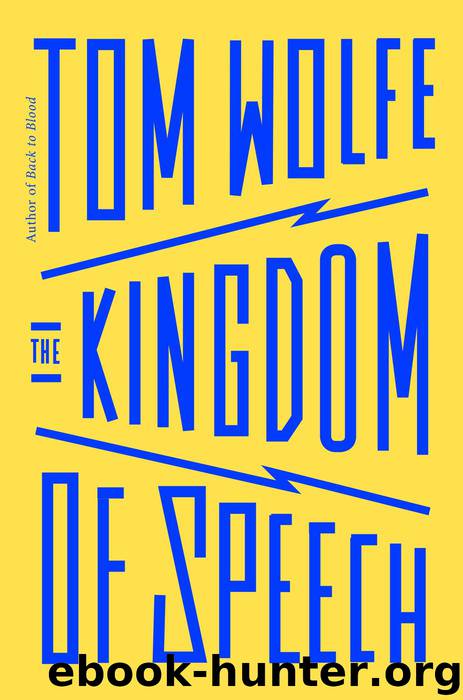The Kingdom of Speech by Tom Wolfe

Author:Tom Wolfe
Language: eng
Format: epub, mobi
Publisher: Little, Brown and Company
Published: 2016-08-29T16:00:00+00:00
c By extending generative grammar to sign language, the editors supported some of Chomsky’s theories but disagreed with others.
Chapter V
What the Flycatcher Caught
By 2005, Noam Chomsky was flying very high. In fact, very high barely says it. The man was…in…orbit. He had made over an entire field of study in his own likeness and put his name on it. If anybody brought up the subject of linguistics, two words inevitably followed: Noam Chomsky. After all, in 2002, so old (at seventy-three) he was already a professor emeritus, he had topped even himself. He had discovered and, as linguistics’ reigning authority, decreed the Law of Recur—
OOOF!—right into the solar plexus!—a twenty-five-thousand-word article in the August–October 2005 issue of Current Anthropology entitled “Cultural Constraints on Grammar and Cognition in Pirahã,” by one Daniel L. Everett. Pirahã was apparently a language spoken by several hundred—estimates ranged from 250 to 500—members of a tribe, the Pirahã (pronounced Pee-daa-hannh), isolated deep within Brazil’s vast Amazon basin (2,670,000 square miles, about 40 percent of South America’s entire landmass). Ordinarily, Chomsky was bored brainless by all those tiny little languages that old-fashioned flycatchers like Everett were still bringing back from out in “the field.” But this article was an affront aimed straight at him, by name, harping on two points: first, this particular tiny language, Pirahã, had no recursion, none at all, immediately reducing Chomsky’s law to just another feature found mainly in Western languages; and second, it was the Pirahã’s own distinctive culture, their unique ways of living, that shaped the language—not any “language organ,” not any “universal grammar” or “deep structure” or “language acquisition device” that Chomsky said all languages had in common.
It was unbelievable, this attack!—because Chomsky remembered the author, Daniel L. Everett, very well. At least twenty years earlier, in the 1980s, Everett had been a visiting scholar at MIT after working toward an ScD in linguistics from Brazil’s University of Campinas (Universidade Estadual de Campinas). He was a starstruck Chomskyite at the time.b He had an office right across the hall from Chomsky himself. In 1983 Everett received his doctorate from Campinas after writing his dissertation along devout Chomskyan lines, and he didn’t stop there. In 1986 he rewrote the dissertation into a 126-page entry in the Handbook of Amazonian Languages.122 It was very nearly an homage to Chomsky. Now that he had his ScD he took periodic breaks in his work with the Pirahã to teach at Campinas, at the University of Pittsburgh as chairman of the linguistics department, and at the University of Manchester in England, where he was professor of phonetics and phonology when he wrote his fateful paper on Pirahã’s cultural restraint for Current Anthropology.123
In his twenty-two years as an off-and-on faculty member, he had written three books and close to seventy articles for learnéd journals, most of them about his work with the Pirahã. But this was his first bombshell. It was one of the ten most cited articles in Current Anthropology’s fifty-plus-year history.
The blast set off no Ahahhs! let alone Ahuras! within the field, however.
Download
This site does not store any files on its server. We only index and link to content provided by other sites. Please contact the content providers to delete copyright contents if any and email us, we'll remove relevant links or contents immediately.
Born to Run: by Christopher McDougall(7065)
The Leavers by Lisa Ko(6912)
iGen by Jean M. Twenge(5366)
Sapiens by Yuval Noah Harari(5294)
The Kite Runner by Khaled Hosseini(5085)
Spare by Prince Harry The Duke of Sussex(5074)
Machine Learning at Scale with H2O by Gregory Keys | David Whiting(4186)
Bullshit Jobs by David Graeber(4096)
Never by Ken Follett(3795)
Goodbye Paradise(3728)
Livewired by David Eagleman(3685)
Fairy Tale by Stephen King(3220)
A Dictionary of Sociology by Unknown(3031)
Harry Potter 4 - Harry Potter and The Goblet of Fire by J.K.Rowling(2990)
The Social Psychology of Inequality by Unknown(2941)
The Club by A.L. Brooks(2862)
Will by Will Smith(2794)
0041152001443424520 .pdf by Unknown(2784)
People of the Earth: An Introduction to World Prehistory by Dr. Brian Fagan & Nadia Durrani(2702)
